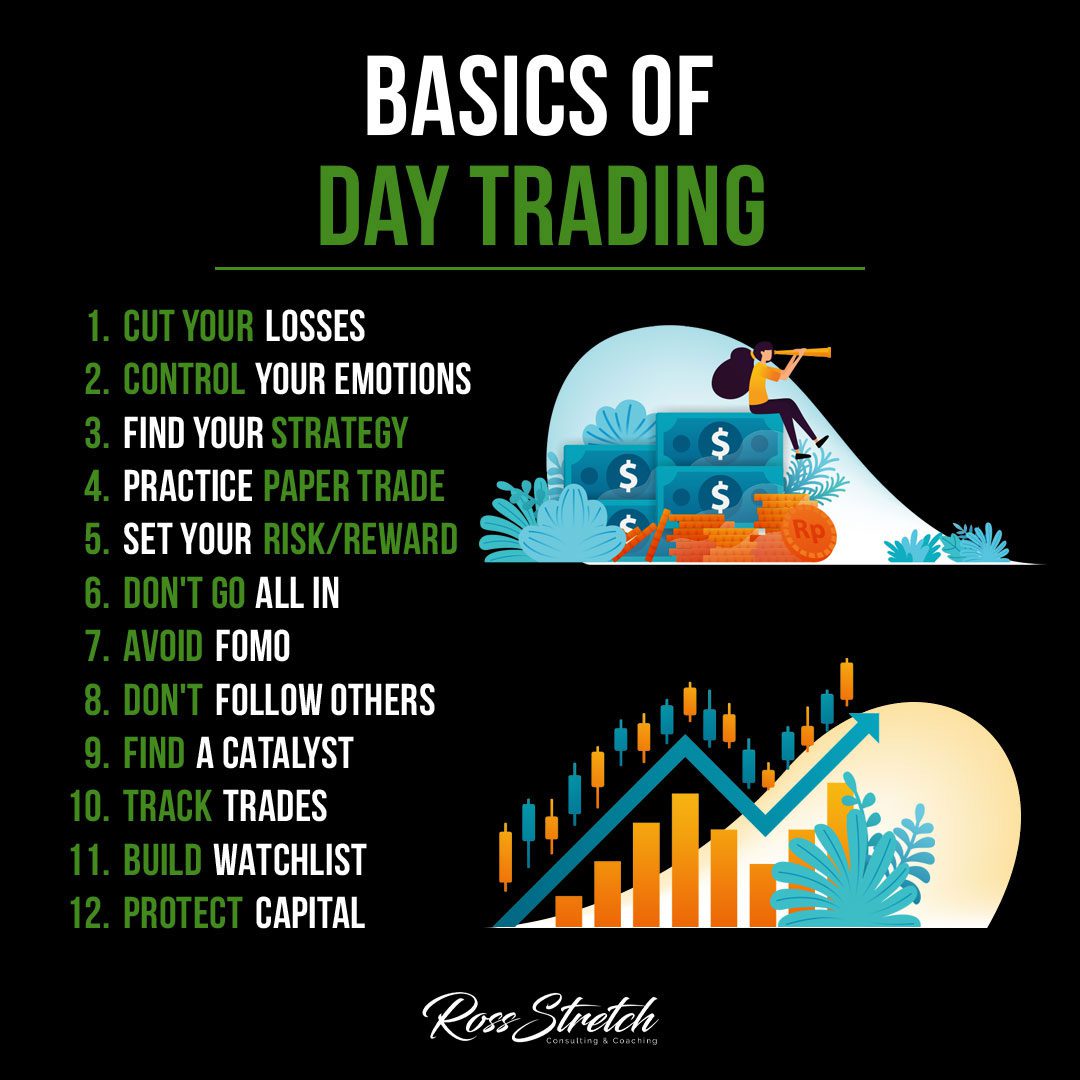Introduction:
Day trading is a thrilling and potentially lucrative endeavor that requires knowledge, discipline, and strategic decision-making. In this infographic, we explore the basics of day trading and provide essential strategies to protect and grow your capital in this fast-paced environment. From managing losses to controlling emotions, finding your trading style, and building a watchlist, these key principles will set you on the path to becoming a successful day trader.
Cut Your Losses
- Establish risk management rules: Determine the maximum amount you are willing to lose on each trade and stick to it.
- Use stop-loss orders: Set stop-loss orders to automatically exit a trade if it reaches a predetermined price, limiting potential losses.
- Don’t chase losing trades: Recognize when a trade isn’t going as planned and exit promptly to minimize losses.
Control Your Emotions
- Stay disciplined: Follow your trading plan and avoid impulsive decisions driven by fear or greed.
- Manage stress: Develop techniques to cope with the inherent pressure of day trading, such as meditation, exercise, or journaling.
- Learn from losses: Instead of dwelling on losses, analyze them objectively and use them as learning opportunities to improve your strategy.
Find Your Strategy
- Understand different trading styles: Explore various day trading strategies, such as scalping, momentum trading, or swing trading, and choose one that aligns with your goals and personality.
- Technical analysis: Utilize chart patterns, indicators, and other technical tools to identify potential trade setups and make informed decisions.
- Fundamental analysis: Stay updated on news, earnings reports, and economic data that may impact the markets and influence your trading decisions.
Practice Paper Trade
- Utilize virtual trading platforms: Practice trading without risking real money by using simulated trading accounts or paper trading platforms.
- Test your strategies: Experiment with different approaches and refine your trading plan in a risk-free environment before committing real capital.
- Monitor performance: Track your paper trades, analyze the results, and identify areas for improvement to enhance your real trading performance.
Set Your Risk/Reward
- Determine risk/reward ratios: Set clear profit targets and determine acceptable risk levels for each trade.
- Calculate risk/reward ratios: Assess potential gains and losses before entering a trade to ensure the potential reward justifies the risk taken.
- Maintain a favorable risk/reward balance: Avoid trades with unfavorable risk/reward ratios that could erode your capital over time.
Don’t Go All In
- Diversify your trades: Spread your capital across multiple trades to minimize the impact of potential losses on your overall portfolio.
- Avoid over-trading: Focus on quality setups and avoid the temptation to enter trades based on impulse or FOMO (Fear of Missing Out).
Avoid FOMO (Fear of Missing Out)
- Stick to your plan: Don’t let fear of missing out drive impulsive trading decisions. Stick to your trading strategy and wait for high-probability setups.
- Patience is key: Wait for confirmation and let the market come to you. It’s better to miss a trade than to enter a low-quality trade driven by FOMO.
Don’t Follow Others Blindly
- Be independent: Make your trading decisions based on your analysis and strategy rather than blindly following the crowd.
- Do your own research: Conduct thorough research and analysis to validate trade ideas and ensure they align with your trading plan.
- Stay true to your style: Avoid getting swayed by others’ opinions or hot tips that may not align with your trading strategy.
Find a Catalyst
- Identify market catalysts: Look for events, news, or factors that can significantly impact stock prices, such as earnings releases, product launches, or regulatory changes.
- Capitalize on volatility: Trade stocks that have a catalyst that can generate significant price movements, providing opportunities for profitable trades.
Track Trades
- Maintain a trading journal: Record your trades, including entry and exit points, reasoning behind the trade, and lessons learned.
- Analyze performance: Regularly review your trading journal to identify patterns, strengths, and weaknesses in your trading strategy.
- Adjust and improve: Use the insights gained from tracking trades to refine your approach and enhance your profitability over time.
Build Your Watchlist
- Identify potential trade opportunities: Research and create a watchlist of stocks that meet your criteria and show potential for favorable trading setups.
- Monitor market conditions: Stay updated on market trends, news, and industry developments that can impact the stocks on your watchlist.
- Prioritize quality over quantity: Focus on a smaller number of stocks that you have thoroughly researched and understand well.
Protect Your Capital
- Use proper position sizing: Determine the appropriate amount to invest in each trade based on your risk tolerance and overall portfolio size.
- Implement risk management strategies: Set stop-loss orders, trail stops, or utilize options to limit potential losses and protect your capital.
- Preserve trading capital: Avoid excessive trading, risking too much on a single trade, or letting emotions drive irrational decisions that can deplete your capital.
Conclusion:
Mastering the basics of day trading requires a combination of knowledge, discipline, and strategy. By implementing these essential principles – cutting losses, controlling emotions, finding your strategy, practicing paper trading, setting risk/reward ratios, avoiding FOMO, and protecting your capital – you can increase your chances of success in the fast-paced world of day trading. Remember, day trading is a continuous learning process, and refining your skills over time will ultimately lead to better trading outcomes. So, embrace these fundamentals, stay focused, and navigate the markets with confidence.


